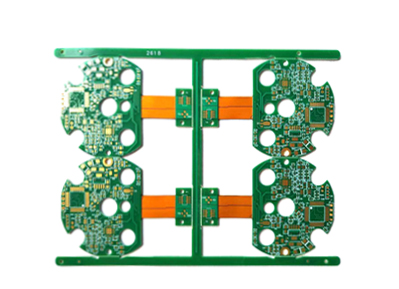The most commonly used material for rigid PCBs (Printed Circuit Boards) is a laminate composed of layers of fiberglass cloth impregnated with epoxy resin, known as FR-4 (Flame Retardant 4). FR-4 is a widely recognized and standardized material for rigid PCBs due to its excellent electrical, mechanical, and thermal properties. Here are some key characteristics of FR-4:

1.Electrical Properties: FR-4 has good electrical insulation properties, high dielectric strength, and low electrical loss. It provides reliable insulation between conductive traces and layers on the PCB.
2.Mechanical Properties: FR-4 offers good mechanical strength and rigidity, providing structural support to the PCB. It can withstand the mechanical stresses and vibrations encountered during normal operation.
3.Thermal Properties: FR-4 has moderate thermal conductivity, which helps in dissipating heat generated by electronic components on the PCB. It also has a reasonable coefficient of thermal expansion (CTE), which ensures dimensional stability during temperature variations.
4.Flame Retardancy: FR-4 materials are designed to be flame retardant, meaning they have a low susceptibility to burning and help prevent the spread of fire.
FR-4 is available in different grades, such as FR-4 Standard, FR-4 High-Tg (High Glass Transition Temperature), and FR-4 Halogen-Free. High-Tg FR-4 has an increased glass transition temperature, making it more suitable for applications that experience higher operating temperatures. Halogen-free FR-4 materials are used in environmentally conscious applications as they eliminate or reduce the presence of halogens (chlorine and bromine compounds), which can release toxic gases when burned.
In addition to FR-4, there are other specialized materials used for specific applications. For example:
Metal Core PCBs (MCPCBs): These PCBs have a metal core, such as aluminum or copper, which provides improved heat dissipation. They are commonly used in high-power LED lighting, automotive lighting, and power electronics.
Ceramic PCBs: Ceramic materials, such as alumina (Al2O3) or aluminum nitride (AlN), are used for PCBs that require exceptional thermal conductivity and high-frequency performance. Ceramic PCBs are often used in RF/microwave applications and power electronics.
It's worth noting that the choice of PCB material depends on the specific requirements of the application, including electrical performance, thermal management, mechanical strength, and cost considerations. Consulting with PCB manufacturers and material suppliers can help in selecting the most appropriate material for your project.
Get more knowledge about What material is used for rigid PCB please refer to Rigaopcb:https://www.rigaopcb.com/